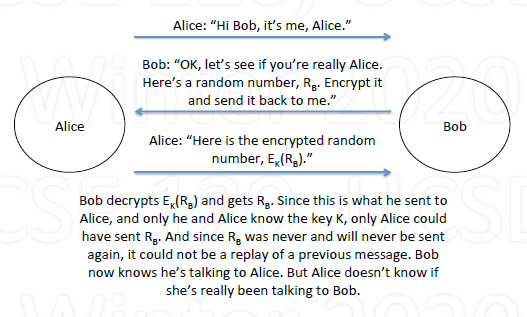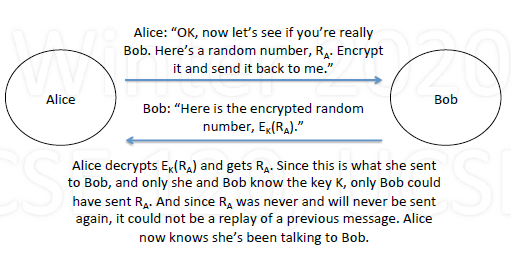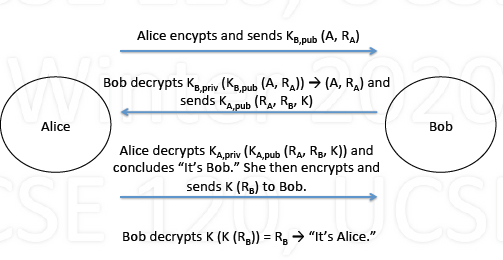本文是我在上UCSD的 CSE 120: Principles of Operating Systems (Winter 2020) 整理的笔记,这一课主要介绍了操作系统里面的不同环境以及系统之间的威胁,包括病毒等,除此之外还介绍了一些安全机制,包括公钥和私钥的方法。
Basic
What is Computer Security?
How to protect computer systems
- System contents: data, software, hardware
- System operation: performance, reliability
- System service: what the user sees and expects
From various threats
- Theft
- Damage
- Disruption
Aspects of Security
Confidentiality
- keeping a secret secret; for authorized eyes only
Integrity
- maintaining accuracy; only authorized changes
Authenticity
- Is it really who/what it claims to be?
Availablity
- access to info/resources you need, when needed
Security Threats
Interception
- eavesdropping
Interruption
- destroying, denial of service
Modification
- tampering with data or programs
Fabrication
- new data/programs, replaying message
User Authentication
Password
Passwords are most common method
- User and computer know secret
- User proves knowledge of secret
- Computer checks
Encrypted passwords
- Computer stores only encrypted passwords
- User provides password
- Computer encrypts, checks
Problem with passwords
Assume 100 possible characters for passwords
| # chars| # passwords | 100G/s machine | 100T/s machine |
| :—-: | :—-: | :—-: | :—-: |
| 6 | $100^6$ | 10 sec | 10 msec |
| 7 | $100^7$ | 17 min | 10 msec |
| 8 | $100^8$ | 1.2 days | 1.7min |
| 9 | $100^9$ | 116 days | 2.8 hr|But most characters are uncommon, hard to remember
- Using dictionary words (~250,000): only 2.5 usec!
Challenge/Response Protocol
Challenge/response, algorithm passwords
- User and system know secret algorithm
- System challenge user’s knowledge, user responds
Example: say secret algorithm is $f(x) = x^2$
- System challenges user: sends system 9
- User computes $f(x) = 9$, sends system 9
- System concludes user must know secret algorithm
- Next time, system can provide different challenge
Secret is never sent, only challenge/response
Threats
Trojan Horse
- Greeks invaded Troy in hollow wooden horse
Program that contains hidden malicious code
- User thinks program does something useful
- In actuality, it (also) does something harmful
Program runs as process in user’s domain
- Can do harm to user’s environment
- Can do harm under that user’s name
Trap Door
- Secret access point in program
- Designer develops program for someone else
- Once loaded in system, designer can access
Consider if trap door is added by compiler
- Compiler adds trap doors to programs
- Designer of compiler can then access
- Can’t tell from program source code
- Even if new compiler written, must be compiled!
Virus
- Code attached to legitimate program
When program runs, the virus runs
- causes damage
- spreads, attaching itself to other programs
Disinfectants
- Check that programs look normal (modified)
- Check for known virus patterns in programs
Internet Worm
- Worm: program that copies itself over network by email, finger, rsh attack
Denial of Service
Preventing others from using system
- by using lots of resources
- by bombarding with network requests or traffic
Example
- Repeatly request TCP connection
- Don’t answer responses; system times them out
- Eventually, no TCP ports left available
Approach to clear (prevent) threats
Intrusion Detection
Intrusion Detection
- Detecting if there is an intruder, or an attack
Signature-based
- Look for specific patterns of attack behavior
- Example: repeated login attempts
Anomaly-based
- Look for unusual behavior
- Example: unusual command/system call patterns
Solution: create audit trail (log), then analyze it
Crytography
Basics
Encoding messages to
- limit who can view the original message
determine who sent a message

Secret Key Encryption
Secret key (symmetric)
- Same key K is used to encrypt and decrypt
- Sender encrypts $E_k(P)$, Receiver decrypts $D_k(E_k(P))$
DES: Data Encryption Standard (1997)
- Weak due to 56-bit keys
AES: Advanced Encryption Standard (2001)
- 128, 192, 256-bit keys
Public Key Encryption
Public key (asymetric)
- Different keys to encrpyt and decrypt
- Each user has two keys: one public, one private
If A wants to send to B
- A encrypts using B’s public key
- B decrypts using its private key
RSA (Rivest, Shamir and Adelman)
Public key vs. Secret key
Secret key
- Operates fast
- Difficult to distribute keys
Public key
- Time-consuming operation (generating random/prime number, see example below)
- Conveninet for key distribution
Example: Alice chats with Bob
Bob authenticates Alice

Alice authenticates Bob

Authentication using public key
- Alice: sends $K_{B,pub}(A, R_A)$ to Bob (uses Bob’s public key)
Bob:
- Decrypts: $K_{B,priv}(K_{B,pub}(A, R_A))\rightarrow (A, R_A)$
- Encrypts and sends $K_{A,pub}(R_A, R_B, K)$ to Alice
Alice:
- Decrypts: $K_{A,priv}(K_{A,pub}(R_A, R_B, K))\rightarrow$ “It’s Bob”
- Encrypts and sends $K(R_B)$ to Bob
Bob: Decrypts $K(K(R_B)) = R_B \rightarrow$ “it’s Alice”
whole process:

Digitial Signatures
If Alice wants to digitially sign message to Bob
Encrypt M using $K_{A,priv}$ and send $K_{A,priv}(M)$ to Bob

When Bob receives, decrypts using $K_{A, pub}$
- can decrypt only if from Alice
To sign and keep private
- Alice sends $K_{B,pub}(M, K_{A, pirv}(M))$ to Bob
- Only Bob can decryptL $K_{B,priv}(K_{B,pub}(M, K_{A,priv}(M))$
Decrypts using $K_{A,pub}$ proving Alice signed it
